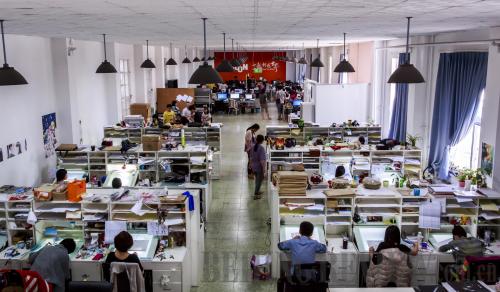|
 |
|
BUSY WORKSHOP: Beijing-based Vasoon Animation Co. Ltd., founded in 1992, is the oldest private animation company in China (CFP) |
Efforts yield results
While the Vasoon team was still working to concoct a sufficiently compelling story, other animation groups were also fighting to gain position in the world of film.
In 2006, a Shenzhen-based computer graphics company called Institute of Digital Media Technology Limited (IDMT) released the 3D animated feature Thru the Möbius Strip, which was billed as the "most expensive animation from a Chinese company," to show the world that China could also produce hi-tech cartoons.
However, the producers soon found themselves in financial disaster: the movie cost almost 130 million yuan ($21.2 million) to make but only grossed about 3 million yuan (about $490,000) at the box office. It was a new direction that Chinese animators had tried to explore, but failed.
That same year, the Central Government stepped in to offer support to this fledgling industry. A government circular called for providing technological innovation funds to technology-based small and medium-sized enterprises, while supporting them through preferential income and value-added tax policies. The Ministry of Culture assumed oversight of the animated film and comic book sectors in late 2009.
Local governments reacted to the Central Government's 2006 and 2009 decisions by encouraging animation companies to set up shop with subsidized office leases, tax breaks and outright payments for finished products.
Between 2006 and 2010, the industry's financial value grew an average of 30 percent annually, according to the Ministry of Culture. By 2010, the combined animated film and comic book industries were worth more than 47 billion yuan ($7.7 billion).
Total television cartoon output rose to about 3,700 hours from 1,300 hours over that period, according to statistics from the ministry, while the number of animated films produced increased from 12 to 46. In 2010 alone, producers churned out nearly 2,200 hours of animated films combined. As of late 2010, more than 40 government-supported animation industry "bases" were operating nationwide.
Wang said that such growth would have been impossible without government subsidies.
A developing industry
Despite all this support, the market for domestic animation is still not promising. In 2008, DreamWorks Animation's original Kung Fu Panda was the first animated feature to gross more than 100 million yuan ($16.3 million) in China. The film that made a global cinematic hero of China's national mascot was a wake-up call to the domestic animation industry.
The domestically produced Pleasant Goat and Big Big Wolf, which was inspired by the hugely successful animated TV series, emerged as a dark horse and made 127 million yuan ($20.7 million) during the 2010 Chinese Lunar New Year holiday season.
In 2011, The Legend of Rabbit, the first 3D animation movie made in China, was released. Though it showed a marked improvement in the quality of animation and special effects, the market didn't respond well. The movie drew in only 20 million yuan ($3.3 million) in China but cost around 150 million ($24.5 million) to make.
Wang Lei, CEO of Shanghai-based Mister Cartoon Pictures, said that the sector is struggling in part due to a lack of professional staffers. Original productions are particularly hard to make, because "there's a shortage of people who can tell stories."
Thus, Wang said, the animation industry has found itself in an awkward position. Speculators, not long-term investment sources, are chasing government-subsidized businesses and producing low-quality films. And because the output quality is poor, the industry has a hard time attracting investors and professionals.
Compared to those firms, Vasoon is lucky: It has gathered talented animators with a strong passion for the industry. The founders, Wang Chuan and Wu Hanqing, even sold their house to invest in the group's movies.
"These people are passionate intellectuals who want to prove that, while Japan has had the upper hand in the industry for a long time, its China's turn now," said Stefanie Zhang, Vasoon's overseas distribution manager, who joined the group in 2010 after leaving a job programming the Taiwan International Animation Festival.
For Wang Chuan, the warm domestic response to Kuiba now is a cheerful sign. "We hope Vasoon and the Kuiba series can help pave the way for the younger generations in the domestic animation industry," he said.
Email us at: yuanyuan@bjreview.com | 